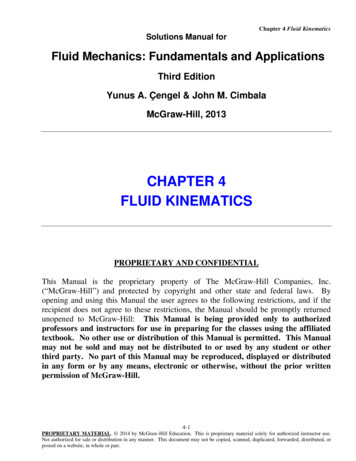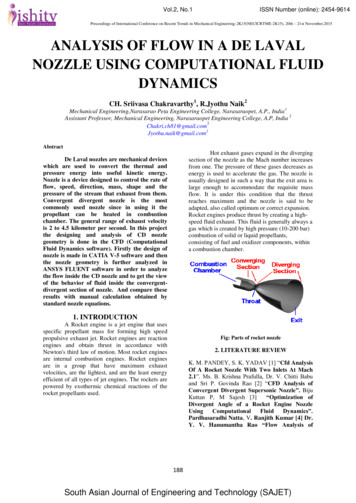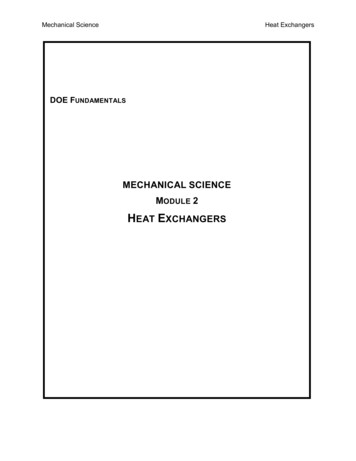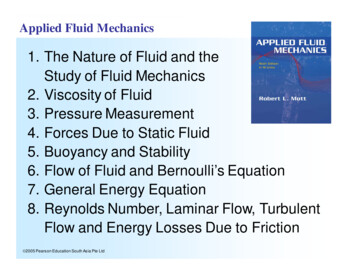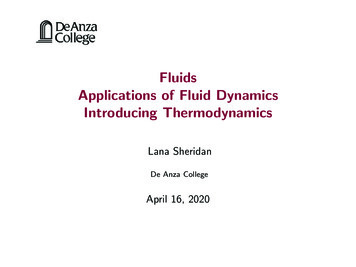
Transcription
FluidsApplications of Fluid DynamicsIntroducing ThermodynamicsLana SheridanDe Anza CollegeApril 16, 2020
Last time fluid dynamics the continuity equation Bernoulli’s equation
Review QuestionQuick Quiz 14.41 You are shipwrecked and floating in the middleof the ocean on a raft. Your cargo on the raft includes a treasurechest full of gold that you found before your ship sank, and theraft is just barely afloat. To keep you floating as high as possible inthe water, should you(i) leave the treasure chest on top of the raft,(ii) secure the treasure chest to the underside of the raft, or(iii) hang the treasure chest in the water with a rope attached tothe raft?(Assume throwing the treasure chest overboard is not an optionyou wish to consider.)A option (ii) is the bestB option (iii) is the bestC options (ii) and (iii) would be the same, better than (i)D All would be the same1Serway & Jewett, page 425.
Overview Torricelli’s law applications of Bernoulli’s equation heat, thermal equilibrium, and the 0th law
Bernoulli’s Equation and the Continuity EquationA law discovered by the 18th-century Swiss scientist, DanielBernoulli.Bernoulli’s PrincipleAs the speed of a fluid’s flow increases, the pressure in the fluiddecreases.The Continuity equation:A1 v1 A2 v2Bernoulli’s Equation:1P ρv 2 ρgh const2is constant along a streamline in the fluid.
Torricelli’s Law from Bernoulli’s EquationBernoulli’s equation can also be used to predict the velocity ofstreams of water from holes in a container at different depths.
o a modest pressure difference between the stagnant air onw blowmore stronglyLawand watchtheBernoulli’sincreased pressuredifTorricelli’sfromEquationFor a very wide container, the liquid at point 2 is nearly at rest(v2 0), at a height y2 and pressure P.At point 1 is leaves with a velocity v1 , at a height y1 and pressureP0 .in its side at a distancethe atmosphere, and itse air above the liquid isuid as it leaves the holePoint 2 is the surfaceof the liquid.A2PhPoint 1 isthe exitpoint ofthe hole.A1y2her. When the hole ise pressure P at the topspeed. If the pressuree extinguisher must beSP0y1v1Figure 14.20 (Example 14.9)A liquid leaves a hole in a tank0 at1 2speed v .1 2ρv1 ρgy1 1 P0 ρv ρgy2222 P
Torricelli’s Law from Bernoulli’s Equationin its side at a distancethe atmosphere, and itse air above the liquid isuid as it leaves the holePoint 2 is the surfaceof the liquid.A2PhPoint 1 isthe exitpoint ofthe hole.A1y2her. When the hole ise pressure P at the topspeed. If the pressuree extinguisher must beSy1Figure 14.20P0v1(Example 14.9)1A liquidleaves a hole in a tank atρv12 ρgy1 P0 ρgy2 Pspeedv.12Rearranging, and using y h2 h1 ,s2(P P0 )v1 2ghρ
Torricelli’s Law from Bernoulli’s EquationNotice that if the container is open to the air (P P0 ), then thespeed of each jet ispv 2ghwhere h is the depth of the hole below the surface.
Implications of Bernoulli’s PrincipleBernoulli’s principle also explains why in a tornado, hurricane, orother extreme weather with high speed winds, windows blowoutward on closed buildings.
Implications of Bernoulli’s PrincipleBernoulli’s principle also explains why in a tornado, hurricane, orother extreme weather with high speed winds, windows blowoutward on closed buildings.The high windspeed outside the building corresponds to lowpressure.The pressure inside remains higher, and the pressure difference canbreak the windows.It can also blow off the roof!It makes sense to allow air a bit of air to flow in or out of abuilding in extreme weather, so that the pressure equalizes.
Implications of Bernoulli’s PrincipleBernoulli’s principle can help explain why airplanes can fly.Air travels faster over the top of the wing, reducing pressure there.That means the air beneath the wing pushes upward on the wingmore strongly than the air on the top of the wing pushes down.This is called lift.1Diagram from HyperPhysics.
Air Flow over a WingIn fact, the air flows over the wing much faster than under it: notjust because it travels a longer distance than over the top.This is the result of circulation of air around the wing.1Diagram by John S. Denker, av8n.com.
Air Flow over the Top of the Wing: Bound VortexA starting vortex trails the wing. The bound vortex appears overthe wing.Those two vortices counter rotate because angular momentum isconserved.The bound vortex is important to establish the high velocity of theair over the top of the wing.1Image by Ludwig Prandtl, 1934, using water channel & aluminum particles.
Wingtip VorteciesOther vortices also form at the ends of the wingtips.1Photo by NASA Langley Research Center.
Vortices around an Airplane1Diagram by John S. Denker, av8n.com.
Airflow at different Angles of Attack1Diagram by John S. Denker, av8n.com.
Implications of Bernoulli’s PrincipleA stall occurs when turbulence behind the wing leads to a suddenloss of lift.The streamlines over the wing detach from the wing surface.This happens when the plane climbs too rapidly and can bedangerous.1Photo by user Jaganath, Wikipedia.
Implications of Bernoulli’s PrincipleSpoilers on cars reduce lift and promote laminar flow.1Photo from http://oppositelock.kinja.com.
Implications of Bernoulli’s PrincipleWings on racing cars are inverted airfoils that produce downforceat the expense of increased drag.This downforce increases the maximum possible static frictionforce turns can be taken at higher speed.1Photo from http://oppositelock.kinja.com.
Implications of Bernoulli’s PrincipleA curveball pitch in baseballalso makes use of Bernoulli’sprinciple.The ball rotates as it movesthrough the air.Its rotation pulls the airaround the ball, so the airmoving over one side of theball moves faster.This causes the ball to deviatefrom a parabolic trajectory.1Diagram by user Gang65, Wikipedia.
Introducing ThermodynamicsNow something different. (Chapter 19)Thermodynamics is the study of temperature, head transfer, phasechanges, together with energy and work.It focuses on relating the bulk properties and behavior ofsubstances. These bulk properties are usually easily measured.
Introducing ThermodynamicsNow something different. (Chapter 19)Thermodynamics is the study of temperature, head transfer, phasechanges, together with energy and work.It focuses on relating the bulk properties and behavior ofsubstances. These bulk properties are usually easily measured.Why is this interesting? it is a little surprising (philosophically) that it works so well it can help us to understand how the universe is evolving it is really important for technology
HeatHeat is a kind of energy transfer into our out of a system.In the same way we say that something does work on an object, wesay that heat flows from one object to another.Technically, an object does not “contain heat”, heat is just energybeing transferred.The symbol for heat is Q, and units are Joules, J.
describe the system from the same set of choices. (iii) If the systemd thesurface, describe the system from the same set of choices.Heatnergy)dl,gedf sixtotaltotalnd-SystemboundaryThe change in the totalamount of energy inthe system is equal tothe total amount ofenergy that crosses theboundary of the system.WorkHeatKinetic energyPotential energyInternal energyMattertransferElectrical alwavesFigure from Serway & Jewett, 9th ed., page 214.
The Zeroth Law of ThermodynamicsThermodynamic EquilibriumTwo systems are in thermodynamic equilibrium when they wouldnot exchange energy by heat or EM radiation, even when placed inthermal contact.0th LawIf two systems are each in thermodynamic equilibrium with a thirdsystem, then the are in thermodynamic equilibrium with each other.This means that thermodynamic equilibrium is transitive, a bit likethe equal sign.
TemperatureWe can go beyond simply saying that two systems are inequilibrium.We can also compare two systems that are not in equilibrium byanalyzing which way heat is transferred when they are brought intocontact.We create a scale for thermodynamic systems to compare them:temperature, T .1Figure: Tom Benson, Glen Research Center, NASA, www.grc.nasa.gov.
TemperatureIf two systems, A and B are in thermal equilibrium then theirtemperatures are equal,TA TBIf system A transfers heat energy to system B, thenTA TB(Or, system A is “hotter” than system B.)If system B transfers heat energy to system A, thenTA TB
TemperatureIt is not possible to rigorously compare the temperature of objectsjust by touching them.Some substances like metal or ceramic tiles at room temperaturemay feel cool to the touch, while wool at room temperature doesnot feel cool at all.This is due to the fact that some substances transfer heat morequickly than others, and our sense of “hotness” or “coolness” hasmore to do with the rate at which heat is transferred to or from usthan actual the temperature.
Measuring TemperatureDevices for measuring temperatures are called thermometers.All such devices work by employing a substance that changes itsproperties as it changes temperature.
Measuring TemperatureThe most familiar tool for measuring temperature is the mercurythermometer.As the bulb warms, the mercury expands into a thin capillary tube.
Summary Torricelli’s law applications of Bernoulli’s equation thermodynamics: heat, temperature, and the 0th lawTest Wednesday, April 22, in class.
Implications of Bernoulli's Principle Bernoulli's principle also explains why in a tornado, hurricane, or other extreme weather with high speed winds, windows blow outward on closed buildings. The high windspeed outside the building corresponds to low pressure. The pressure inside remains higher, and the pressure di erence can break the .

